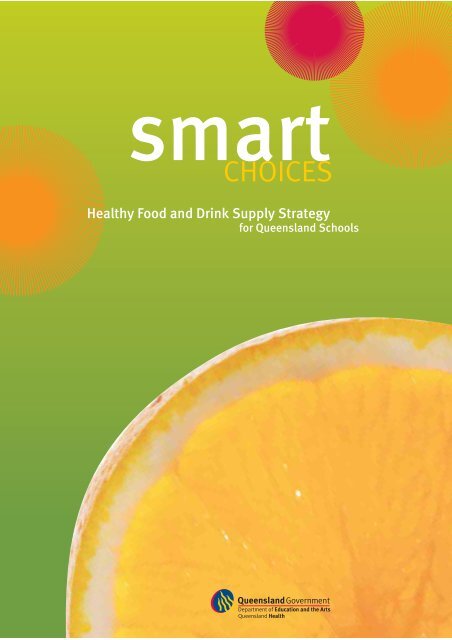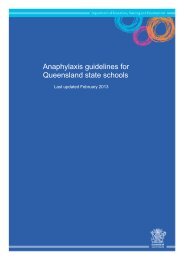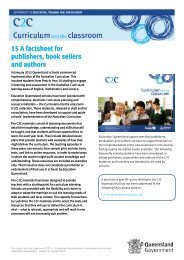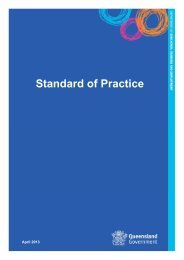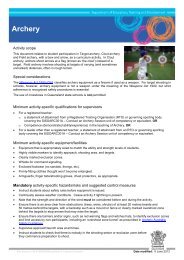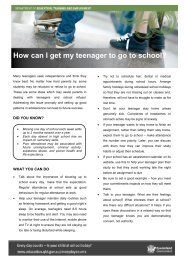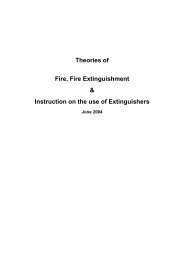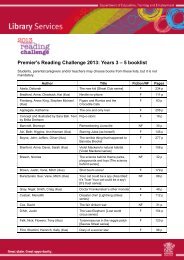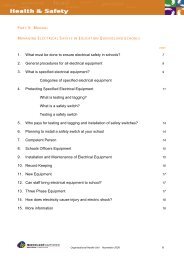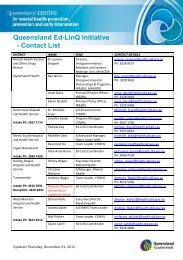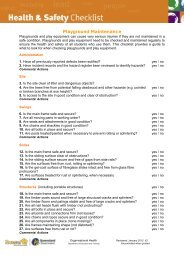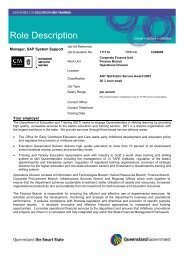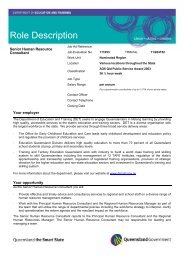Smart Choices - Healthy Food and Drink Supply Strategy for ...
Smart Choices - Healthy Food and Drink Supply Strategy for ...
Smart Choices - Healthy Food and Drink Supply Strategy for ...
You also want an ePaper? Increase the reach of your titles
YUMPU automatically turns print PDFs into web optimized ePapers that Google loves.
smart<br />
CHOICES<br />
<strong>Healthy</strong> <strong>Food</strong> <strong>and</strong> <strong>Drink</strong> <strong>Supply</strong> <strong>Strategy</strong><br />
<strong>for</strong> Queensl<strong>and</strong> Schools<br />
Queensl<strong>and</strong> Health
Acknowledgments<br />
The Queensl<strong>and</strong> Health <strong>and</strong> Education Queensl<strong>and</strong> Joint Work Plan<br />
2004–2007 <strong>Healthy</strong> Weight Working Group has produced a strategy to<br />
address the nutritional value of food <strong>and</strong> drinks supplied in Queensl<strong>and</strong><br />
schools.<br />
The strategy is based on the NSW Department of Health <strong>and</strong> NSW<br />
Department of Education <strong>and</strong> Training Canteen Menu Planning Guide,<br />
2004, which is part of the NSW <strong>Healthy</strong> School Canteen <strong>Strategy</strong>.<br />
Education Queensl<strong>and</strong> <strong>and</strong> Queensl<strong>and</strong> Health wish to thank <strong>and</strong><br />
acknowledge the contribution of the following people in the development<br />
of the <strong>Healthy</strong> <strong>Food</strong> <strong>and</strong> <strong>Drink</strong> <strong>Supply</strong> <strong>Strategy</strong> <strong>for</strong> Queensl<strong>and</strong> Schools.<br />
Working Group<br />
Ms Jacky Dawson, Education Queensl<strong>and</strong> (Chair)<br />
Mr Mathew Dick, Queensl<strong>and</strong> Health (Secretariat)<br />
Mr Tony Kitchen, Queensl<strong>and</strong> Catholic Education Commission<br />
Dr Am<strong>and</strong>a Lee, Queensl<strong>and</strong> Health<br />
Ms Jenene Rosser, Association of Independent Schools Queensl<strong>and</strong><br />
Mr Ian Whitehead, Sport <strong>and</strong> Recreation Queensl<strong>and</strong><br />
Nutrition Reference Group<br />
Australian Dental Association Queensl<strong>and</strong><br />
Australian Medical Association Queensl<strong>and</strong><br />
Diabetes Australia Qld<br />
Dietitians Association of Australia, Queensl<strong>and</strong> Division<br />
Education Queensl<strong>and</strong><br />
Federation of Canteens in Schools (FOCiS)<br />
Federation of Parents <strong>and</strong> Friends Associations<br />
Health Promoting Schools Association Queensl<strong>and</strong><br />
Heart Foundation (Queensl<strong>and</strong> Branch)<br />
Home Economics Institute of Australia (Queensl<strong>and</strong>) Inc.<br />
Nutrition Australia<br />
Queensl<strong>and</strong> Association of School Tuckshops<br />
Queensl<strong>and</strong> Council of Parents <strong>and</strong> Citizens’ Associations Inc.<br />
Queensl<strong>and</strong> Health (Chair)<br />
School Nutrition Action Coalition<br />
The Queensl<strong>and</strong> Independent Schools Parents Council<br />
Copyright protects this publication. Except <strong>for</strong> purposes permitted by<br />
the Copyright Act, reproduction by whatever means is prohibited.<br />
Queensl<strong>and</strong> schools are permitted to make multiple copies of the material<br />
in this book without infringing copyright, provided the number of copies<br />
does not exceed the number of copies required in any one school. Any<br />
inquiries should be addressed to the Copyright Officer, Education<br />
Queensl<strong>and</strong>, PO Box 15033, City East, Qld 4002.<br />
ISBN 0734 519 761<br />
050091
Contents<br />
<strong>Smart</strong> <strong>Choices</strong> 2<br />
Background 3<br />
<strong>Smart</strong> <strong>Choices</strong> <strong>Food</strong> <strong>and</strong> <strong>Drink</strong> Selector 7<br />
Nutrient criteria to identify ‘Occasional’ foods <strong>and</strong> drinks 14<br />
Reading nutrition in<strong>for</strong>mation panels 16<br />
Nutrition in<strong>for</strong>mation <strong>and</strong> serve size 17<br />
Ready Reckoner 19<br />
Resources 24<br />
How to use the CD-ROM 26<br />
1
<strong>Smart</strong> <strong>Choices</strong><br />
In recent years, levels of overweight <strong>and</strong><br />
obesity in children <strong>and</strong> young people have<br />
increased dramatically – now around a quarter<br />
of our children are overweight or obese. This is<br />
a serious issue as overweight <strong>and</strong> obesity carry<br />
a greater risk of a number of immediate <strong>and</strong><br />
long-term health <strong>and</strong> psychosocial problems.<br />
Excess weight gain in children is usually a<br />
result of excess energy intake (kilojoules or<br />
calories) through eating too much food or the<br />
wrong type of food, combined with doing too<br />
little physical activity or being inactive <strong>for</strong> too<br />
much of the day. <strong>Food</strong> <strong>and</strong> drinks consumed<br />
by children also affect oral (dental) health <strong>and</strong><br />
contribute to the high rates of tooth decay in<br />
Queensl<strong>and</strong> children.<br />
The development of a strategy to address the<br />
nutritional value of food <strong>and</strong> drinks supplied at<br />
school or school activities was identified as an<br />
action in the Queensl<strong>and</strong> Health <strong>and</strong> Education<br />
Queensl<strong>and</strong> Joint Work Plan 2004–2007.<br />
The <strong>Healthy</strong> <strong>Food</strong> <strong>and</strong> <strong>Drink</strong> <strong>Supply</strong> <strong>Strategy</strong><br />
<strong>for</strong> Queensl<strong>and</strong> Schools is all about offering<br />
healthy food <strong>and</strong> drink choices to students in<br />
Queensl<strong>and</strong> schools.<br />
School food <strong>and</strong> drink supply includes all<br />
situations where food is supplied in the school<br />
environment – tuckshops, vending machines,<br />
school excursions, school camps, fundraising,<br />
classroom rewards, school events such as<br />
celebrations <strong>and</strong> sports days, <strong>and</strong> food used in<br />
curriculum activities.<br />
The <strong>Healthy</strong> <strong>Food</strong> <strong>and</strong> <strong>Drink</strong> <strong>Supply</strong> <strong>Strategy</strong><br />
<strong>for</strong> Queensl<strong>and</strong> Schools reflects the<br />
Australian Dietary Guidelines <strong>for</strong> Children<br />
<strong>and</strong> Adolescents <strong>and</strong> The Australian Guide<br />
to <strong>Healthy</strong> Eating (AGTHE). In<strong>for</strong>mation is<br />
provided about the following areas:<br />
the nutritional value of foods<br />
the most appropriate (<strong>and</strong> healthiest) food<br />
choices<br />
the nutrient criteria <strong>for</strong> identifying foods<br />
<strong>and</strong> drinks that need to be restricted.<br />
To support the implementation of the strategy<br />
a <strong>Smart</strong> <strong>Choices</strong> resource package has been<br />
produced which comprises:<br />
<strong>Healthy</strong> <strong>Food</strong> <strong>and</strong> <strong>Drink</strong> <strong>Supply</strong> <strong>Strategy</strong> <strong>for</strong><br />
Queensl<strong>and</strong> Schools including the <strong>Food</strong> <strong>and</strong><br />
<strong>Drink</strong> Selector<br />
<strong>Food</strong> <strong>and</strong> <strong>Drink</strong> Spectrum poster<br />
CD-ROM containing a copy of the strategy,<br />
which includes the <strong>Food</strong> <strong>and</strong> <strong>Drink</strong> Selector,<br />
‘Occasional’ <strong>Food</strong> <strong>and</strong> <strong>Drink</strong> Criteria<br />
table, <strong>Food</strong> <strong>and</strong> <strong>Drink</strong> Spectrum <strong>and</strong> a<br />
presentation <strong>for</strong> use by schools <strong>and</strong> Parents<br />
<strong>and</strong> Citizens Associations.<br />
The <strong>Smart</strong> <strong>Choices</strong> – <strong>Food</strong> <strong>and</strong> <strong>Drink</strong> Selector<br />
offers a new way of determining which food<br />
<strong>and</strong> drinks are able to be supplied in schools.<br />
Making selections can be a very challenging<br />
task. There are many potential food <strong>and</strong> drink<br />
items that could be supplied in schools. The<br />
in<strong>for</strong>mation provided in this strategy will help<br />
to make this task easier.<br />
The role of schools<br />
Schools have an important role in promoting<br />
healthy eating <strong>and</strong> physical activity to students<br />
<strong>and</strong> providing an environment that supports<br />
a healthy lifestyle. A healthy diet can improve<br />
behaviours critical to educational success <strong>and</strong><br />
per<strong>for</strong>mance at school. Effective school-based<br />
nutrition <strong>and</strong> health interventions can also<br />
help improve academic per<strong>for</strong>mance.<br />
Tuckshops are an important part of the school<br />
environment; they can model healthy food<br />
<strong>and</strong> drink choices that are tasty, interesting<br />
<strong>and</strong> af<strong>for</strong>dable, <strong>and</strong> provide the means to put<br />
into practice nutrition messages taught in the<br />
classroom.<br />
Background<br />
The <strong>Healthy</strong> <strong>Food</strong> <strong>and</strong> <strong>Drink</strong> <strong>Supply</strong> <strong>Strategy</strong> <strong>for</strong><br />
Queensl<strong>and</strong> Schools is based on the Australian<br />
Dietary Guidelines <strong>for</strong> Children <strong>and</strong> Adolescents<br />
(2003) <strong>and</strong> The Australian Guide to <strong>Healthy</strong><br />
Eating (AGTHE).<br />
Australian Dietary Guidelines <strong>for</strong><br />
Children <strong>and</strong> Adolescents<br />
The Australian Dietary Guidelines <strong>for</strong> Children<br />
<strong>and</strong> Adolescents (2003) were developed by the<br />
National Health <strong>and</strong> Medical Research Council<br />
as a useful tool to promote healthy eating<br />
patterns. They are based on the best scientific<br />
evidence available <strong>and</strong> current knowledge<br />
about what children need to grow <strong>and</strong> develop<br />
to their optimum potential. The guidelines are<br />
not listed in order of importance <strong>and</strong> should be<br />
considered together as a package rather than<br />
in isolation.<br />
The Australian Dietary Guidelines <strong>for</strong> Children <strong>and</strong> Adolescents<br />
Encourage <strong>and</strong> support breastfeeding.<br />
Children <strong>and</strong> adolescents need sufficient nutritious foods to grow <strong>and</strong> develop normally.<br />
Growth should be checked regularly <strong>for</strong> young children.<br />
Physical activity is important <strong>for</strong> all children <strong>and</strong> adolescents.<br />
Enjoy a wide variety of nutritious foods.<br />
Children <strong>and</strong> adolescents should be encouraged to:<br />
eat plenty of vegetables, legumes <strong>and</strong> fruits<br />
eat plenty of cereals, (including breads, rice, pasta <strong>and</strong> noodles), preferably wholegrain<br />
include lean meat, fish, poultry <strong>and</strong>/or alternatives<br />
include milks, yoghurt, cheese <strong>and</strong>/or alternatives. Reduced fat milks are not suitable <strong>for</strong> young children under two<br />
years old, because of their energy needs, but reduced fat varieties should be encouraged <strong>for</strong> older children <strong>and</strong><br />
adolescents<br />
choose water as a drink.<br />
<strong>and</strong> care should be taken to:<br />
limit saturated fat <strong>and</strong> moderate total fat intake. Low fat diets are not suitable <strong>for</strong> infants<br />
choose foods low in salt<br />
consume only moderate amounts of sugars <strong>and</strong> foods containing added sugars.<br />
Care <strong>for</strong> your child’s food: prepare <strong>and</strong> store it safely.<br />
Source: <strong>Food</strong> <strong>for</strong> Health: Dietary Guidelines <strong>for</strong> Children <strong>and</strong> Adolescents in Australia, National Health <strong>and</strong> Medical Research Council.<br />
2 3
<strong>Food</strong> safety<br />
The Australian Dietary Guidelines now include<br />
a guideline about food safety in recognition of<br />
the importance of being vigilant when preparing<br />
<strong>and</strong> serving food. Schools, including the<br />
tuckshop, have a responsibility to maintain safe<br />
food-h<strong>and</strong>ling practices <strong>and</strong> high st<strong>and</strong>ards<br />
of hygiene. This is essential to avoid food<br />
poisoning <strong>and</strong> ensure students have access to<br />
high-quality, safe <strong>and</strong> suitable food.<br />
Many resources are available to assist in<br />
meeting safe food-h<strong>and</strong>ling requirements <strong>and</strong><br />
are listed on pages 24–25.<br />
The Australian Guide to <strong>Healthy</strong> Eating<br />
The Australian Guide to <strong>Healthy</strong> Eating provides<br />
in<strong>for</strong>mation about the amounts <strong>and</strong> kinds of<br />
food we need each day from the five basic food<br />
groups to obtain sufficient nutrients <strong>for</strong> good<br />
health <strong>and</strong> wellbeing <strong>and</strong> is consistent with the<br />
Australian Dietary Guidelines.<br />
The Australian Guide to <strong>Healthy</strong> Eating, Commonwealth<br />
Copyright 1998, is reproduced with permission of the Australian<br />
Government Department of Health <strong>and</strong> Ageing, 2005.<br />
The basic five food groups<br />
While the Australian Dietary Guidelines<br />
provide the general framework <strong>for</strong> how <strong>and</strong><br />
what should be eaten, the AGTHE provides<br />
more specific advice regarding the number of<br />
serves needed from each of the basic five food<br />
groups.<br />
The AGTHE uses a plate model, divided into<br />
different sized segments, to indicate the<br />
proportions of food from each of the five food<br />
groups that we should be eating <strong>for</strong> good<br />
health. <strong>Food</strong>s are grouped together because<br />
they share a similar range of nutrients. Over<br />
three-quarters of food intake should come from<br />
three major food groups – the breads, cereals,<br />
rice, pasta <strong>and</strong> noodles group, the vegetables<br />
<strong>and</strong> legumes group, <strong>and</strong> the fruit group.<br />
Extra foods<br />
Some foods do not fit into the five food groups<br />
because they are not essential to provide the<br />
nutrients needed. They are regarded as ‘extra’<br />
foods <strong>and</strong> include biscuits, cakes, desserts,<br />
pastries, soft drinks, high-fat snack items such<br />
as crisps, pies, pasties, sausage rolls <strong>and</strong> other<br />
takeaways, lollies <strong>and</strong> chocolates.<br />
Most of these foods are high in fat (particularly<br />
saturated fat), <strong>and</strong>/or salt <strong>and</strong>/or added sugar<br />
<strong>and</strong> <strong>for</strong> these reasons it is recommended their<br />
intake is limited. When eaten only occasionally<br />
or in small serves they can add variety to the<br />
diet without replacing the healthier foods<br />
needed each day.<br />
How many serves?<br />
The number of serves of different foods<br />
children <strong>and</strong> young people should eat on<br />
average each day depends on an individual’s<br />
body size <strong>and</strong> activity level.<br />
The table below provides a guide to the<br />
number of serves of each of the five food<br />
groups that children <strong>and</strong> young people should<br />
aim to eat each day. Very active children <strong>and</strong><br />
young people may need more each day than<br />
shown in the table.<br />
Children can consume up to one-third of their<br />
daily nutritional intake at school. As many<br />
children regularly purchase food from school<br />
tuckshops, it is important that tuckshops<br />
provide a wide variety of foods from the five<br />
food groups <strong>and</strong> promote <strong>and</strong> model healthy<br />
food choices.<br />
What is a serve?<br />
Recommended number of daily serves <strong>for</strong> children <strong>and</strong> young people<br />
Example serves in the table on the following<br />
page define the amount of food that equals<br />
one serve within each food group. For example,<br />
two slices of bread or one medium bread roll is<br />
equivalent to one serve. Read the table below<br />
in conjunction with the table on the following<br />
page to work out how much food from each<br />
food group to aim <strong>for</strong> each day.<br />
4–7 Years 8–11 Years 12–18 Years<br />
Cereals (including breads, rice, pasta, noodles) 5–7 6–9 5–11<br />
Vegetables, legumes 2 3 4<br />
Fruit 1 1 3<br />
Milk, yoghurt, cheese 2 2 3<br />
Lean meat, fish, poultry, nuts <strong>and</strong> legumes 1/2 1 1<br />
Extra foods (have no more than) 1–2 1–2 1–3<br />
Source: The Australian Guide to <strong>Healthy</strong> Eating, Commonwealth Department of Health <strong>and</strong> Family Services, 1998.<br />
4 5
Examples of a serve<br />
Bread, cereals, rice, pasta, noodles<br />
2 slices of bread<br />
1 medium bread roll<br />
1 cup cooked rice, pasta, or noodles<br />
Vegetables <strong>and</strong> legumes (choose a variety)<br />
Starchy vegetables<br />
1 medium potato or yam<br />
½ medium sweet potato<br />
1 medium parsnip<br />
Dark green leafy vegetables<br />
½ cup cabbage, spinach, silverbeet, broccoli, cauliflower or brussel sprouts<br />
1 cup cooked porridge<br />
1 cup breakfast cereal flakes or 1/2 cup muesli<br />
Legumes <strong>and</strong> other vegetables<br />
1 cup lettuce or salad vegetables<br />
½ cup broad beans, lentils, peas, green beans, zucchini, mushrooms, tomatoes, capsicum, cucumber, sweetcorn,<br />
turnips, swede, sprouts, celery, eggplant etc.<br />
Fruit<br />
1 piece medium sized fruit (<strong>for</strong> example apple,<br />
orange, mango, m<strong>and</strong>arin, banana, pear, peach etc.)<br />
2 pieces of smaller fruit <strong>for</strong> example apricots, kiwi<br />
fruit, plums, figs<br />
1 cup diced pieces or canned fruit<br />
Milks, yoghurt, cheese <strong>and</strong> alternatives<br />
250 ml glass or one cup of milk (can be fresh, long<br />
life or reconstituted milk)<br />
½ cup evaporated milk<br />
40 g (2 slices) of cheese<br />
250 ml (1 cup custard)<br />
½ cup fruit juice<br />
¼ medium melon (rockmelon, honeydew)<br />
Dried fruit <strong>for</strong> example 4 dried apricots, 1½ tablespoons<br />
sultanas<br />
About 20 grapes or cherries<br />
About 8 strawberries<br />
200 g (1 small carton) of yoghurt, plain or fruit, or, as an<br />
alternative try:<br />
1 cup of calcium-<strong>for</strong>tified soy milk<br />
½ cup pink salmon with bones<br />
Meat, fish, poultry <strong>and</strong> alternatives<br />
65–100 g cooked meat or chicken (<strong>for</strong> example ½ cup mince, 2 small chops or 2 slices roast meat)<br />
80–120 g cooked fish fillet, or as an alternative try:<br />
2 small eggs<br />
½ cup cooked (dried) beans, lentils, chick-peas, split peas or canned beans<br />
1/3 cup peanuts or almonds<br />
Extras<br />
These foods can occasionally be included <strong>for</strong> variety. They are generally higher in saturated fat <strong>and</strong>/or sugar, kilojoules<br />
<strong>and</strong> salt.<br />
Some examples include:<br />
30 g potato crisps<br />
1 small–medium piece of plain cake or 1 bun<br />
1 slice pizza = 2 extras<br />
3–4 plain sweet biscuits<br />
1 can soft drink or 2 glasses cordial<br />
Half a small chocolate bar<br />
2 scoops ice-cream<br />
60 g jam, honey (1 tablespoon)<br />
1 meat pie or pasty = 3 extras<br />
2 tablespoons of cream or mayonnaise<br />
Source: The Australian Guide to <strong>Healthy</strong> Eating, Commonwealth Department of Health <strong>and</strong> Family Services, 1998.<br />
The smart choices food<br />
<strong>and</strong> drink selector<br />
The <strong>Smart</strong> <strong>Choices</strong> – <strong>Food</strong> <strong>and</strong> <strong>Drink</strong> Selector<br />
on pages 7–18 assists with making selections<br />
on foods <strong>and</strong> drinks to be supplied in<br />
schools. <strong>Food</strong>s <strong>and</strong> drinks have been<br />
classified into three categories<br />
according to their nutritional value:<br />
Green, Amber <strong>and</strong> Red.<br />
GREEN ‘Have plenty’<br />
Encourage <strong>and</strong> promote these foods<br />
<strong>and</strong> drinks in the school.<br />
AMBER ‘Select carefully’<br />
Do not let these foods <strong>and</strong> drinks dominate<br />
choices <strong>and</strong> avoid large serve sizes.<br />
RED ‘Occasional’<br />
Limit the availability of these foods <strong>and</strong> drinks<br />
to no more than two occasions per term.<br />
You will note that there is a clear distinction<br />
between the AMBER <strong>and</strong> RED categories. This<br />
is because foods in the RED category are to<br />
be available on no more than two occasions<br />
per term. A set of nutrient criteria is provided<br />
(on page 15) that will enable you to determine<br />
whether a certain food sits within the RED<br />
category.<br />
Staff <strong>and</strong> parents also eat from the school<br />
tuckshop. While their needs may be different<br />
to children, it is important that adults in the<br />
school model healthy food choices.<br />
Links to the school curriculum<br />
The school curriculum seeks to improve<br />
students’ underst<strong>and</strong>ing of good nutrition<br />
<strong>and</strong> develop the skills to make positive health<br />
decisions. Learning about healthier food<br />
choices may encourage children to try new<br />
foods. Classroom activities also provide an<br />
opportunity <strong>for</strong> students to be involved in<br />
planning <strong>and</strong> promoting healthier foods.<br />
The <strong>Smart</strong> <strong>Choices</strong> – <strong>Food</strong> <strong>and</strong> <strong>Drink</strong> Spectrum<br />
which appears on the following page is<br />
a visual guide that shows where certain<br />
foods <strong>and</strong> drinks fit. The spectrum has been<br />
reproduced as a poster <strong>and</strong> accompanies this<br />
resource package.<br />
6 7
smart<br />
CHOICES <strong>Food</strong><br />
<strong>and</strong> drink<br />
SPECTRUM<br />
‘Have Plenty’<br />
‘Select carefully’<br />
These foods <strong>and</strong> drinks<br />
are to be supplied<br />
on no more than two<br />
occasions per term.<br />
Encourage <strong>and</strong> promote these foods<br />
<strong>and</strong> drinks.<br />
These foods <strong>and</strong> drinks:<br />
are excellent sources of important nutrients<br />
are low in saturated fat <strong>and</strong>/or added sugar <strong>and</strong>/or salt<br />
help to avoid an intake of excess energy (kilojoules or<br />
calories)<br />
Do not let these foods <strong>and</strong> drinks dominate<br />
the choices <strong>and</strong> avoid large serving sizes.<br />
These foods <strong>and</strong> drinks:<br />
have some nutritional value<br />
have moderate amounts of saturated fat <strong>and</strong>/or<br />
added sugar <strong>and</strong>/or salt<br />
can, in large serve sizes, contribute excess energy<br />
(kilojoules or calories)<br />
‘Occasionally’<br />
These foods <strong>and</strong> drinks:<br />
lack adequate nutritional value<br />
are high in saturated fat <strong>and</strong>/or sugar <strong>and</strong>/or salt<br />
can contribute excess energy (kilojoules or calories)<br />
Queensl<strong>and</strong> Health<br />
Based on the NSW Department of Health <strong>and</strong> NSW Department of Education <strong>and</strong> Training, Canteen Menu Planning Guide 2004.<br />
Based on the NSW Department of Health <strong>and</strong> NSW Department of Education <strong>and</strong> Training Canteen Menu Planning Guide 2004, which is part of the NSW <strong>Healthy</strong> School Canteen <strong>Strategy</strong>.<br />
‘Have plenty’ – the GREEN category<br />
These foods <strong>and</strong> drinks should be encouraged<br />
<strong>and</strong> promoted to students as the best choice<br />
<strong>and</strong> included as a major part of the daily<br />
school tuckshop menu. <strong>Food</strong>s from this<br />
category of the food <strong>and</strong> drink spectrum are<br />
the best choices because in general they:<br />
are excellent sources of important nutrients<br />
are low in saturated fat <strong>and</strong>/or added sugar<br />
<strong>and</strong>/or salt<br />
help to avoid an intake of excess energy<br />
(kilojoules)<br />
<strong>Food</strong>s <strong>and</strong> drinks in this category are based on<br />
the basic five food groups <strong>and</strong> The Australian<br />
Dietary Guidelines. Included are bread, cereals,<br />
rice, pasta, noodles, vegetables, fruit, reducedfat<br />
milk, yoghurt, cheese, lean meat, fish,<br />
poultry, eggs, nuts <strong>and</strong> legumes. Providing<br />
a range of healthy food choices is important<br />
<strong>for</strong> variety. Water is an important part of this<br />
category.<br />
Within this category even healthier choices<br />
can be made. Wholegrain breads <strong>and</strong><br />
cereal products are healthier because they<br />
incorporate all of the natural grain <strong>and</strong> are<br />
higher in fibre. For example: air-popped<br />
popcorn, high-fibre breakfast cereals,<br />
wholemeal, rye <strong>and</strong> high-fibre breads <strong>and</strong><br />
crispbreads. Fruits that are eaten with the skin<br />
on are also higher in fibre.<br />
Encourage <strong>and</strong> promote these foods <strong>and</strong><br />
drinks<br />
<strong>Food</strong>s <strong>and</strong> drinks from the GREEN category can<br />
be marketed as tasty, less-expensive choices.<br />
Take every opportunity to include foods from<br />
this category as part of the school tuckshop<br />
menu. For example, add at least one salad<br />
vegetable to s<strong>and</strong>wiches <strong>and</strong> rolls, add salad<br />
to burgers, <strong>and</strong> serve chilled or frozen fruit<br />
pieces at lunchtime.<br />
8 9
Presentation is an important factor in<br />
selection. Colour, flavour, texture <strong>and</strong><br />
temperature are key ingredients in the<br />
successful presentation of food <strong>and</strong> drinks. If<br />
it looks good <strong>and</strong> tastes great – students will<br />
buy it!<br />
Promote food <strong>and</strong> drinks in the GREEN category<br />
at all occasions where food <strong>and</strong> drinks are<br />
supplied.<br />
The Queensl<strong>and</strong> Association of School<br />
Tuckshops <strong>and</strong> Nutrition Australia have helpful<br />
The GREEN Category<br />
<strong>Food</strong> type Examples<br />
resources to assist you to encourage <strong>and</strong><br />
promote these foods. See the contact list on<br />
page 24.<br />
The following in<strong>for</strong>mation provides a broad<br />
description <strong>and</strong> example of the types of food<br />
<strong>and</strong> drinks that fit into the GREEN category of<br />
the spectrum.<br />
For more in<strong>for</strong>mation on better choices within<br />
the GREEN category <strong>and</strong> ways of serving these<br />
foods <strong>and</strong> drinks, refer to the Ready Reckoner<br />
on pages 19–23.<br />
Breads White, multigrain, wholemeal, rye, hi-fibre breads or rolls including: burritos,<br />
English muffins, focaccia, lavash, Lebanese, pita, raisin/fruit, tortillas <strong>and</strong> Turkish.<br />
Some corn crispbreads <strong>and</strong> rice cakes also fit into GREEN.<br />
Cereal foods Rice, pasta, noodles, polenta <strong>and</strong> burghul (often used in tabouleh salad).<br />
Breakfast cereals Wholegrain breakfast cereals that are high in fibre <strong>and</strong> lower in salt <strong>and</strong> sugar.<br />
Vegetables Fresh <strong>and</strong> frozen vegetables used in a variety of different ways.<br />
Fruit Washed fresh fruits, frozen, canned <strong>and</strong> dried fruits.<br />
Legumes All <strong>for</strong>ms of prepared beans <strong>and</strong> peas – baked beans, red kidney beans, soy beans,<br />
mung beans, lentils, chick-peas, peas, bean curd, tofu <strong>and</strong> pappadums (made from<br />
legume flour).<br />
Reduced-fat dairy products Reduced-fat milk (plain <strong>and</strong> flavoured), yoghurt, cheese <strong>and</strong> custard.<br />
Lean meat, fish, poultry <strong>and</strong> Lean chicken, beef, lamb, pork, canned tuna <strong>and</strong> salmon, <strong>and</strong> eggs.<br />
alternatives<br />
Unsalted plain <strong>and</strong> mixed nuts.<br />
<strong>Drink</strong>s Water is the best drink <strong>and</strong> a great thirst quencher!<br />
Reduced fat milk <strong>and</strong> soy drinks also fit into the GREEN category.<br />
‘Select carefully’ – the AMBER category<br />
Selecting foods <strong>and</strong> drinks carefully means:<br />
reducing the number of AMBER foods <strong>and</strong><br />
drinks supplied <strong>and</strong> selecting healthier<br />
choices from this category<br />
offering some of these foods <strong>and</strong> drinks<br />
only on certain days of the week<br />
avoiding large serving sizes.<br />
AMBER foods are mainly processed foods that<br />
have had some sugar, salt or fat added to<br />
them. These foods should be selected carefully<br />
because in general they:<br />
have some nutritional value<br />
have moderate amounts of saturated fat<br />
<strong>and</strong>/or added sugar <strong>and</strong>/or salt<br />
can, in large serve sizes, contribute excess<br />
energy (kilojoules).<br />
Don’t let these foods <strong>and</strong> drinks dominate<br />
The foods <strong>and</strong> drinks that are found in the<br />
AMBER category offer convenience. It is<br />
acknowledged that this is very important in<br />
a tuckshop setting. However, these products<br />
should not dominate the menu at the expense<br />
of healthier choices. A selection that consists<br />
mostly of AMBER foods will provide students<br />
with food choices containing too many<br />
kilojoules at the expense of the fresh food<br />
choices that children <strong>and</strong> young people need<br />
<strong>for</strong> health <strong>and</strong> vitality.<br />
Avoid large serving sizes<br />
There is a general trend towards serving or<br />
packaging foods <strong>and</strong> drinks in larger serving<br />
sizes, <strong>for</strong> example, some meat pies are 25<br />
per cent bigger today than they were several<br />
years ago. Eating foods <strong>and</strong> drinks in larger<br />
serve sizes makes it easier to consume excess<br />
kilojoules. Select moderate serve sizes instead.<br />
If you are packaging <strong>and</strong> promoting foods <strong>and</strong><br />
drinks in the tuckshop consider the size of the<br />
serve.<br />
Select healthier choices within the AMBER<br />
category<br />
There are healthier product choices within the<br />
AMBER category of the spectrum that contain<br />
reduced levels of saturated fat, salt or sugar<br />
when compared to the regular products.<br />
To assist you in selecting foods <strong>and</strong> drinks<br />
that are healthier choices use the Nutrition<br />
Australia school tuckshop product guide or<br />
the FOCiS Star Choice Registered Product List<br />
available from the Queensl<strong>and</strong> Association of<br />
School Tuckshops.<br />
Types of foods <strong>and</strong> drinks that fit into<br />
AMBER<br />
The following in<strong>for</strong>mation provides a broad<br />
description of the types of foods <strong>and</strong> drinks<br />
that are likely to fit into the AMBER category of<br />
the spectrum. For more in<strong>for</strong>mation on better<br />
choices <strong>and</strong> ways of serving these products,<br />
refer to the Ready Reckoner on pages 19–23.<br />
10 11
The AMBER Category<br />
<strong>Food</strong> type Examples<br />
Full-fat dairy foods Milk (plain <strong>and</strong> flavoured), yoghurt, frozen yoghurt, custard <strong>and</strong> cheese.<br />
Full-fat flavoured milks in large serve sizes can contribute excess energy (kilojoules).<br />
Savoury commercial products There are many savoury commercial food products in the marketplace. Check labels<br />
against the nutrient criteria (on page 15) to ensure products fit into AMBER <strong>and</strong> not<br />
into the RED category.<br />
Examples include savoury pastries, spring rolls <strong>and</strong> dim sims, pasta products such as<br />
lasagne, pizza, oven-baked potato products, sausages, frankfurters, meat patties (not<br />
crumbed), meat balls <strong>and</strong> chicken drumsticks.<br />
Choose foods from a registered product list.<br />
Processed meats Use in small amounts only, as larger serve sizes can provide too much saturated fat<br />
<strong>and</strong>/or salt. Examples include devon, ham, salami, bacon, chicken roll, corned beef<br />
<strong>and</strong> pastrami.<br />
Margarine, mayonnaise <strong>and</strong> Choose polyunsaturated or mono-unsaturated varieties <strong>and</strong> use sparingly.<br />
oil<br />
Make sure you can see the bread through the spread!<br />
Spreads Use sparingly. Choose reduced-salt varieties where available. Examples include<br />
peanut butter <strong>and</strong> other nut spreads, fish, chicken <strong>and</strong> meat paste, yeast <strong>and</strong><br />
vegetable extract spreads.<br />
Sauces <strong>and</strong> gravy Use sparingly. Choose reduced-salt varieties where available. Examples include<br />
tomato sauce, sweet chilli sauce <strong>and</strong> gravy. Some sauces (<strong>for</strong> example satay) also<br />
contain nut products which are a common allergen.<br />
Snack food bars Check the label against the nutrient criteria (on page 15).<br />
Examples include breakfast bars, cereal bars <strong>and</strong> fruit bars.<br />
Savoury snack foods <strong>and</strong> Check the label against the nutrient criteria (on page 15). Examples most likely to fit<br />
biscuits<br />
here include oven-baked snack biscuits, popcorn <strong>and</strong> some dry biscuits.<br />
Cakes, muffins <strong>and</strong> sweet<br />
biscuits<br />
Check the label against the nutrient criteria (on page 15). Some un-iced cakes,<br />
muffins <strong>and</strong> sweet biscuits that are a small to medium serve size or have been<br />
modified (<strong>for</strong> example reduced levels of fat <strong>and</strong>/or sugar <strong>and</strong> include fibre) may fit<br />
into the AMBER category.<br />
Ice-creams Ice-creams that are not coated in chocolate, premium or of a large serve size are<br />
likely to fall into the AMBER category, such as plain milk-based ice-creams <strong>and</strong> frozen<br />
yoghurts.<br />
Ice blocks, fruit-based ice<br />
confection <strong>and</strong> slushees<br />
Check the label against the nutrient criteria (on page 15). Watch the serve size <strong>and</strong><br />
choose carefully.<br />
<strong>Drink</strong>s Stock fruit juice of no more than 250 ml, as in large amounts it can contribute excess<br />
kilojoules. Fruit drinks – choose those with greater than 50% fruit juice. These drinks<br />
contribute to tooth decay because of their high acidity level <strong>and</strong> should not be<br />
consumed frequently.<br />
Full-fat soy drinks also fit into the AMBER category.<br />
Breakfast cereals Refined breakfast cereals with added sugars <strong>and</strong>/or saturated fat fit in the AMBER<br />
category.<br />
Many commercial products may fit into either<br />
the RED or AMBER category. Read the labels<br />
<strong>and</strong> assess against the ‘Occasional’ <strong>Food</strong> <strong>and</strong><br />
<strong>Drink</strong> Criteria on page 15 or select products<br />
from the registered products list available<br />
through Nutrition Australia <strong>and</strong> the FOCiS Star<br />
Choice list available through the Queensl<strong>and</strong><br />
Association of School Tuckshops to make more<br />
suitable choices.<br />
‘Occasional’ foods <strong>and</strong> drinks – the RED category<br />
The ‘occasional’ foods <strong>and</strong> drinks that make<br />
up the RED category of the <strong>Food</strong> <strong>and</strong> <strong>Drink</strong><br />
Spectrum are based on the ‘extra’ foods as<br />
defined in The Australian Guide to <strong>Healthy</strong><br />
Eating.<br />
It is recommended that these foods <strong>and</strong> drinks<br />
are only consumed occasionally, because they:<br />
lack adequate nutritional value<br />
are high in saturated fat, <strong>and</strong>/or added<br />
sugar <strong>and</strong>/or salt<br />
can contribute excess energy (kilojoules)<br />
can contribute to tooth decay <strong>and</strong> erosion.<br />
Limit to no more than two occasions per<br />
term<br />
<strong>Food</strong>s <strong>and</strong> drinks which fit into the RED<br />
category should be supplied on no more than<br />
two occasions per term. It is important to be<br />
consistent across all areas of food provision<br />
in the school. This includes the tuckshop,<br />
The RED Category<br />
<strong>Food</strong> type Examples<br />
Sugar <strong>and</strong> artificially sweetened<br />
drinks<br />
Confectionery/lollies All types<br />
Deep-fried foods All types<br />
vending machines, fundraising, classroom<br />
rewards, excursions, camps, celebrations,<br />
sports days, Enterprise Education activities<br />
<strong>and</strong> curriculum activities.<br />
Types of food that fit into the RED category<br />
A set of nutrient criteria is provided to work<br />
out whether a food or drink fits into the RED<br />
category of the <strong>Food</strong> <strong>and</strong> <strong>Drink</strong> Spectrum<br />
(see page 8). There are many commercial<br />
products that may fall into either RED or AMBER<br />
categories depending on their nutrient content.<br />
Compare the label against the ‘Occasional’<br />
<strong>Food</strong> <strong>and</strong> <strong>Drink</strong> criteria. The Ready Reckoner<br />
on pages 19–23 can also help you to make<br />
decisions about these products.<br />
The table below provides a broad description<br />
of the types of foods <strong>and</strong> drinks that fall into<br />
the RED category of the spectrum.<br />
Soft drinks, artificially sweetened soft drinks, energy drinks, sports<br />
drinks <strong>and</strong> flavoured mineral waters<br />
Savoury snack foods Crisps, chips <strong>and</strong> other similar products<br />
Ice-creams Chocolate coated <strong>and</strong> premium ice-creams<br />
Cakes, muffins, sweet pastries<br />
<strong>and</strong> slices<br />
Croissants, doughnuts, cream-filled buns/cakes, sweet pastries, slices<br />
Medium to large serves of many cakes <strong>and</strong> muffins<br />
12 13
Nutrient criteria to identify ‘Occasional’<br />
foods <strong>and</strong> drinks<br />
The ‘Occasional’ (RED) food <strong>and</strong><br />
drink criteria<br />
The tables on page 15 list a set of nutrient<br />
criteria <strong>for</strong> each category of food <strong>and</strong> drink<br />
that needs to be assessed. There are two main<br />
groupings:<br />
hot food items<br />
snack foods <strong>and</strong> drinks.<br />
Each category’s characteristics have been<br />
considered in the development of the criteria.<br />
Total fat <strong>and</strong> added sugar are not included<br />
in the criteria. By setting a limit on the total<br />
kilojoule content of the product, the amount<br />
of fat or sugar that can be added is restricted.<br />
Within the two main groupings of hot food<br />
items, <strong>and</strong> snack foods <strong>and</strong> drinks, there are a<br />
number of categories.<br />
Hot foods are assessed per 100 g due to<br />
the wide variation in serve sizes within this<br />
grouping.<br />
Snack foods <strong>and</strong> drinks are assessed ‘per<br />
serve’. The ‘per serve’ measure is provided<br />
<strong>for</strong> ease of use. It applies to those products<br />
that are generally pre-packaged into individual<br />
serves.<br />
Large serving sizes <strong>and</strong> excess intake of energy<br />
have been addressed by limiting the kilojoule<br />
content per serve of foods <strong>and</strong> drinks in the<br />
snack foods <strong>and</strong> drinks categories.<br />
Assessing a product against the<br />
criteria<br />
Use the ‘Occasional’ food <strong>and</strong> drink criteria<br />
table on page 15 to determine if a food or drink<br />
fits into the RED category of the spectrum.<br />
There are two examples on pages 17–18 to<br />
help you underst<strong>and</strong> how to use the Nutrition<br />
In<strong>for</strong>mation Panel on product labels to assess<br />
it against the nutrient criteria.<br />
The ‘Occasional’ food <strong>and</strong> drink<br />
criteria table<br />
If the hot food item you are considering<br />
has more than the number specified in the<br />
energy, saturated fat or sodium column it is an<br />
‘Occasional’ food <strong>and</strong> drink (RED category).<br />
If the snack food or drink product you are<br />
considering has more than the number<br />
specified in the energy, saturated fat or sodium<br />
column or less than the number in the fibre<br />
column, it is an ‘Occasional’ food or drink (RED<br />
category).<br />
The ‘Occasional’ (RED) food <strong>and</strong><br />
drink criteria tables<br />
Hot food items assessed per 100 g<br />
Category Nutrient Criteria<br />
<strong>Food</strong> or drink Energy (kilojoules) Saturated Fat (g) Sodium (mg)<br />
per 100 g<br />
per 100 g<br />
per 100 g<br />
Savoury pastries, pasta,<br />
pizzas, oven-baked<br />
potato products<br />
>1000 kJ >5 g >400 mg<br />
Crumbed <strong>and</strong> coated<br />
foods, frankfurters,<br />
sausages<br />
Snack foods <strong>and</strong> drinks assessed per serve<br />
Category Nutrient Criteria<br />
<strong>Food</strong> or drink Energy<br />
(kilojoules)<br />
per serve<br />
Sugar-sweetened drinks<br />
<strong>and</strong> ices*<br />
Snack food bars <strong>and</strong><br />
sweet biscuits<br />
Savoury snack foods<br />
<strong>and</strong> biscuits<br />
Ice creams <strong>and</strong> dairy<br />
desserts<br />
Cakes, muffins <strong>and</strong><br />
sweet pastries etc.<br />
>1000 kJ >5 g >700 mg<br />
Note: All DEEP-FRIED FOODS fit into the RED end of the spectrum <strong>and</strong> their supply should be limited in schools. They are<br />
too high in kilojoules <strong>and</strong> fat (usually saturated fat).<br />
Key: > means more than, < means less than.<br />
Saturated Fat<br />
(g) per serve<br />
14<br />
15<br />
Sodium<br />
(mg) per<br />
serve<br />
>300 kJ >100 mg<br />
Fibre<br />
(g) per serve<br />
>600 kJ >3 g 600 kJ >3 g >200 mg<br />
>600 kJ >3 g<br />
>900 kJ >3 g means more than, < means less than.<br />
Based on the NSW Department of Health <strong>and</strong> NSW Department of Education <strong>and</strong> Training Canteen Menu Planning Guide, 2004, which is<br />
part of the NSW <strong>Healthy</strong> School Canteen <strong>Strategy</strong>.
Reading nutrition in<strong>for</strong>mation panels<br />
<strong>Food</strong> <strong>and</strong> drink labels – how to read<br />
them<br />
In<strong>for</strong>mation on food <strong>and</strong> drink labels can<br />
be confusing. When you know how to read<br />
them, you’ll find the label the best source of<br />
in<strong>for</strong>mation about a product.<br />
Nutrition In<strong>for</strong>mation Panels that<br />
manufacturers attach to their products allow<br />
you to work out whether or not they fit into the<br />
RED category of the spectrum.<br />
Example Nutrition In<strong>for</strong>mation Panel<br />
Servings per package: 8<br />
Serving size: 60 g<br />
What’s on a label?<br />
There is a lot of in<strong>for</strong>mation on labels today.<br />
The focus here is on the Nutrition In<strong>for</strong>mation<br />
Panel. The nutrients are displayed in a<br />
st<strong>and</strong>ard <strong>for</strong>mat, providing quantity per serve<br />
<strong>and</strong> quantity per 100 g (or 100 ml if liquid) of<br />
the food.<br />
Reading Nutrition In<strong>for</strong>mation Panels<br />
Nutrition In<strong>for</strong>mation Panels provide<br />
in<strong>for</strong>mation on the amount of energy<br />
(kilojoules), protein, total fat, saturated fat,<br />
carbohydrate, sugars <strong>and</strong> sodium (salt), as well<br />
as any other nutrient about which a claim is<br />
made (<strong>for</strong> example fibre, iron, calcium).<br />
Tip: Always check the serve size of the product.<br />
The serve quoted on some food <strong>and</strong> drink<br />
labels may not be the same as the serve size<br />
sold in the tuckshop.<br />
QUANTITY PER 60 g SERVING QUANTITY PER 100 g<br />
ENERGY 467 kJ (112 cal) 1555 kJ (372 cal)<br />
PROTEIN 2.6 g 8.6 g<br />
FAT<br />
– Total<br />
0.3 g<br />
1.1 g<br />
– Saturated<br />
0.1 g<br />
0.3 g<br />
CARBOHYDRATE<br />
24.1 g<br />
80.5 g<br />
– Sugars<br />
4.1 g<br />
13.7 g<br />
SODIUM 2 mg 8 mg<br />
Ingredients: Whole wheat, fruit paste (25%), (Dried dates, sultanas, pear juice concentrate, glycerol, blackcurrant juice<br />
concentrate), sugar, vitamins (Niacin, Riboflavin, Thiamine)<br />
Highlights show the nutrients of concern in the ‘Occasional’ <strong>Food</strong> <strong>and</strong> <strong>Drink</strong> Criteria table (see page 15).<br />
Nutrition in<strong>for</strong>mation <strong>and</strong> serve size<br />
Comparing a hot food item against<br />
the criteria<br />
When making a decision about the suitability<br />
of a product to be supplied in a school, the<br />
Nutrition In<strong>for</strong>mation Panel on the package<br />
needs to be compared to the ‘Occasional’ <strong>Food</strong><br />
<strong>and</strong> <strong>Drink</strong> Criteria table. The example below<br />
illustrates how to check the per 100 g column<br />
on the Nutrition In<strong>for</strong>mation Panel.<br />
Example 1: Crumbed Chicken Fillet Burger<br />
Step 1<br />
You have determined this food belongs in the<br />
category: HOT FOOD ITEMS – Crumbed <strong>and</strong> coated<br />
foods.<br />
Hot <strong>Food</strong> Items are assessed per 100 g, there<strong>for</strong>e<br />
look at the per 100 g column on the Nutrition<br />
In<strong>for</strong>mation Panel.<br />
Step 2<br />
Look at the per 100 g column <strong>for</strong> ALL these<br />
nutrients:<br />
Energy (kilojoules)<br />
Saturated fat<br />
Sodium<br />
Remember if any one is greater than the criteria<br />
on the ‘Occasional’ <strong>Food</strong> <strong>and</strong> <strong>Drink</strong> Criteria table<br />
(see page 19) it is then classified as an ‘Occasional’<br />
food or drink (RED category).<br />
Step 3<br />
Compare the Nutrition In<strong>for</strong>mation Panel per 100<br />
g with the criteria from the ‘Occasional’ <strong>Food</strong><strong>and</strong><br />
<strong>Drink</strong> Criteria table (see page 19).<br />
You have now determined that this crumbed<br />
chicken fillet burger is in the AMBER food<br />
category <strong>and</strong> NOT in the RED category.<br />
CATEGORY NUTRIENT CRITERIA<br />
<strong>Food</strong> or <strong>Drink</strong> Energy (kilojoules) per 100 g Saturated Fat (g) per 100 g Sodium (mg) per 100 g<br />
Crumbed <strong>and</strong> coated foods,<br />
frankfurters, sausages<br />
Kilojoules are within<br />
the criteria at<br />
980 kJ/100 g<br />
Nutrition In<strong>for</strong>mation Panel<br />
<strong>for</strong> crumbed chicken fillet burger<br />
Servings per package: 60<br />
Average serving size: 120 g<br />
Quantity Quantity<br />
per serve per 100 g<br />
ENERGY 1176 kJ 980 kJ<br />
PROTEIN<br />
FAT<br />
17.4 g 14.5 g<br />
– Total<br />
15.8 g<br />
13.2 g<br />
– Saturated<br />
4.1 g<br />
3.4 g<br />
CARBOHYDRATE 18.3 g<br />
15.3 g<br />
– Sugars<br />
0.2 g<br />
0.2 g<br />
SODIUM 734 mg 612 mg<br />
Saturated fat is<br />
within the criteria<br />
at 3.4 g/100 g<br />
>1000 kJ >5 g >700 mg<br />
Sodium is within<br />
the criteria at<br />
612 mg/100 g<br />
16 17
Comparing a snack food item against<br />
the criteria<br />
The example below illustrates how to check the<br />
per serve column on the Nutrition In<strong>for</strong>mation<br />
Panel.<br />
Example 2: Baked Savoury Biscuits<br />
Step 1<br />
You have determined this food belongs in the<br />
category: SNACK FOODS AND DRINKS – Savoury<br />
snack foods <strong>and</strong> biscuits.<br />
Snack <strong>Food</strong>s <strong>and</strong> <strong>Drink</strong>s are assessed per serve,<br />
there<strong>for</strong>e look at the per serve column on<br />
the Nutrition In<strong>for</strong>mation Panel.<br />
Step 2<br />
Look at the ‘Quantity per serve’ column<br />
<strong>for</strong> ALL these nutrients:<br />
Energy (kilojoules)<br />
Saturated fat<br />
Sodium<br />
Step 3<br />
Determine your serve size: At your tuckshop you sell<br />
24 biscuits as a serve. This is one <strong>and</strong> a half times<br />
the serve on the label, that is, 16 × 1.5 = 24 biscuits<br />
Step 4<br />
Compare the Nutrition In<strong>for</strong>mation Panel per serve<br />
with the criteria from the ‘Occasional’ <strong>Food</strong> <strong>and</strong><br />
<strong>Drink</strong> Criteria table (see page 20).<br />
Energy: 770 kJ × 1.5 serves = 1155 kJ as served<br />
Saturated Fat: 3.9 g × 1.5 = 5.8 g as served<br />
Sodium: 238 mg × 1.5 = 357 mg as served<br />
You have now determined that at this serving size,<br />
these savoury biscuits ARE an ‘Occasional’ food<br />
or drink (RED category) <strong>and</strong> should be limited <strong>for</strong><br />
supply to no more than two times per term.<br />
This serving of biscuits<br />
is over the set criteria<br />
<strong>for</strong> energy at 1155 kJ<br />
CATEGORY NUTRIENT CRITERIA<br />
Nutrition In<strong>for</strong>mation Panel<br />
<strong>for</strong> Baked Savoury Biscuits<br />
Servings per package: 6<br />
Average serving size: 16 biscuits (35 g)<br />
Quantity per serve Quantity<br />
16 Biscuits (35 g) per 100 g<br />
ENERGY 770 kJ 2195 kJ<br />
PROTEIN<br />
FAT<br />
5.2 g 14.8 g<br />
– Total<br />
8.8 g<br />
25.1 g<br />
– Saturated<br />
3.9 g<br />
11.1 g<br />
CARBOHYDRATE<br />
20.4 g<br />
58.1 g<br />
– Sugars<br />
1.1 g<br />
3.2 g<br />
DIETARY FIBRE 1.4 g 4.0 g<br />
SODIUM 238 mg 678 mg<br />
This serving of biscuits<br />
is over the set criteria<br />
<strong>for</strong> saturated fat at 5.8 g<br />
This serving of biscuits<br />
is over the set criteria<br />
<strong>for</strong> sodium at 357 mg<br />
<strong>Food</strong> or <strong>Drink</strong> Energy (kilojoules) per serve Saturated Fat (g) per serve Sodium (mg) per serve<br />
Savoury snack foods<br />
<strong>and</strong> biscuits<br />
>600 kJ >3 g >200 mg<br />
Ready reckoner of commonly supplied<br />
food <strong>and</strong> drinks<br />
Using the Ready Reckoner<br />
These tables will provide you with a guide to<br />
food <strong>and</strong> drinks commonly supplied in schools,<br />
<strong>and</strong> the category they are most likely to fit into.<br />
Circles in two columns indicate that br<strong>and</strong>s or<br />
varieties of foods <strong>and</strong> drinks in this category<br />
differ <strong>and</strong> may fit into one or other of the<br />
categories shown.<br />
<strong>Food</strong>s Likely part of the food<br />
<strong>and</strong> drink spectrum<br />
Breads <strong>and</strong> alternatives<br />
Select a variety of<br />
different breads,<br />
including wholegrain.<br />
scones – plain or fruit<br />
raisin, fruit bread or<br />
buns<br />
rice <strong>and</strong> corn cakes<br />
Rice <strong>and</strong> noodles<br />
fried rice<br />
stir fried noodles<br />
hot noodle cups<br />
sushi<br />
Green Amber Red<br />
18 19<br />
Comments<br />
Breads can be used in a variety of different ways <strong>for</strong> snacks<br />
<strong>and</strong>/or main meal choices in the school canteen. Choose a<br />
variety of breads to add interest to your canteen menu.<br />
Toasted breads/jaffles served with fillings are a tasty<br />
alternative to s<strong>and</strong>wiches. They are often popular winter<br />
foods.<br />
Rolls can be split, have reduced fat cheese added, wrapped<br />
in foil <strong>and</strong> heated in the food warmer. Some rolls can be<br />
purchased already made up.<br />
Bread cases can be filled with similar fillings to the baked<br />
potatoes.<br />
Toasted raisin/fruit bread or buns are often popular as<br />
snack foods.<br />
Rice <strong>and</strong> corn cakes can be served with interesting<br />
vegetable toppings.<br />
Plain rice <strong>and</strong> noodles are in the GREEN category. Ricebased<br />
<strong>and</strong> noodle-based dishes can be high in sodium <strong>and</strong><br />
saturated fat.<br />
Choose reduced fat <strong>and</strong> salt reduced versions.<br />
Breakfast cereals Choose wholegrain cereals, wholewheat flake <strong>and</strong> puffed<br />
cereals, porridge, <strong>and</strong> wholewheat breakfast biscuits. These<br />
fit into the GREEN category. Serve with reduced-fat milk.<br />
Refined cereals are likely to be in AMBER.<br />
Fruit<br />
fresh<br />
frozen<br />
canned<br />
dried<br />
Any fresh fruit in season – whole, sliced, cubed, wedges,<br />
quarters, spirals (<strong>for</strong> example apple slinkies can be made<br />
using a special peeling <strong>and</strong> slicing machine).<br />
Fruit salad with a mixture of interesting fruit, served cold is<br />
a refreshing alternative. A scoop of reduced-fat ice-cream, a<br />
dollop of custard, yoghurt or fromage frais can add interest<br />
<strong>and</strong> variety.
<strong>Food</strong>s Likely part of the food<br />
<strong>and</strong> drink spectrum<br />
Vegetables<br />
fresh<br />
baked potatoes<br />
corn on the cob<br />
Legumes<br />
baked beans<br />
lentil patties<br />
felafels<br />
Salads<br />
garden/mixed<br />
pasta<br />
potato<br />
rice<br />
tabouleh<br />
coleslaw<br />
egg<br />
Soups<br />
canned<br />
commercially prepared<br />
canteen made<br />
Dairy foods<br />
yoghurt<br />
custard<br />
cheese<br />
fromage frais<br />
milk<br />
Meat/fish/poultry (not<br />
crumbed) <strong>and</strong> alternatives<br />
lean meats (<strong>for</strong><br />
example roast beef)<br />
lean chicken meat (no<br />
skin)<br />
turkey<br />
egg (hard boiled then<br />
mashed or sliced)<br />
fish (<strong>for</strong> example tuna<br />
or salmon in spring<br />
water, sardines)<br />
nuts<br />
meat pattie (not<br />
crumbed)<br />
fish pattie<br />
char-grilled chicken fillet<br />
chicken drumsticks<br />
meat balls<br />
pork spare ribs<br />
Green Amber Red<br />
Reduced fat<br />
Full fat<br />
Comments<br />
Baked potatoes can be cooked in their skins, split <strong>and</strong><br />
filled with choices of s<strong>and</strong>wich fillings; they can also be<br />
filled with creamed corn, tabouleh, savoury mince or baked<br />
beans topped with cheese. Bread cases can also use these<br />
fi llings.<br />
Baked beans can be used in s<strong>and</strong>wiches <strong>and</strong> jaffles as<br />
a meat alternative. Choose salt reduced varieties. Lentil<br />
patties <strong>and</strong> felafels can be used in rolls <strong>and</strong> s<strong>and</strong>wiches or<br />
served with salads.<br />
These salads could be served as a salad plate, box or<br />
tub. Lean meats, chicken, tuna or reduced fat cheese add<br />
protein <strong>and</strong> variety. Salads dressed with lots of oil <strong>and</strong><br />
mayonnaise will fit into AMBER. For the salad to fit in the<br />
GREEN category, select the dressing carefully – no dressing<br />
or a no-oil or reduced-oil dressing is recommended.<br />
Soups either made in the canteen <strong>for</strong> example pumpkin,<br />
vegetable or produced from low-salt commercially prepared<br />
soup mixes can be sold in cups with a bread roll or bread<br />
stick (grissini). If serving soup to younger children, st<strong>and</strong><br />
<strong>and</strong> allow to cool slightly be<strong>for</strong>e serving <strong>for</strong> safety reasons.<br />
Children <strong>and</strong> adolescents of school age do not need the<br />
full-fat varieties of these products. The reduced-fat versions<br />
should be encouraged.<br />
Yoghurt – plain <strong>and</strong> fruit varieties <strong>and</strong> custard can be frozen<br />
in summer <strong>and</strong> sold as a snack.<br />
Fromage frais – reduced fat fruit or vanilla.<br />
See drinks.<br />
These foods are a good source of protein <strong>and</strong> can be used<br />
<strong>for</strong> hot rolls, s<strong>and</strong>wiches, salad plates, pizza topping etc.<br />
Some of these products will fit into the RED category. Check<br />
labels carefully. These products are usually used to make<br />
the following items in the canteen:<br />
– burgers – kebabs<br />
– burritos <strong>and</strong> tacos – focaccias<br />
For a healthy <strong>and</strong> filling meal serve all of the above with salad.<br />
Burritos <strong>and</strong> tacos (fill with reduced fat savoury mince<br />
<strong>and</strong> kidney beans, salad <strong>and</strong> reduced fat yoghurt; chicken<br />
burritos are a tasty alternative).<br />
<strong>Food</strong>s Likely part of the food<br />
<strong>and</strong> drink spectrum<br />
Processed meats<br />
devon<br />
ham<br />
chicken roll<br />
corned beef<br />
bacon<br />
pastrami<br />
salami<br />
Crumbed chicken, fish or<br />
vegetable products<br />
chicken nuggets<br />
chicken fillet wedges<br />
chicken patty<br />
fish fingers<br />
fish burgers<br />
vegetable patties<br />
battered saveloys <strong>and</strong><br />
sausages (beef, lamb<br />
<strong>and</strong> chicken varieties)<br />
frankfurters<br />
Commercial oven-baked<br />
potato products<br />
wedges<br />
chips<br />
hash browns<br />
scallops<br />
gems<br />
Pasta products<br />
lasagne<br />
spaghetti bolognaise<br />
macaroni cheese<br />
Pizza<br />
hawaiian<br />
supreme<br />
cheese <strong>and</strong> bacon<br />
muffin <strong>and</strong> pita breadbased<br />
pizzas<br />
Green Amber Red<br />
20 21<br />
Comments<br />
These foods are usually high in sodium <strong>and</strong>/or saturated fat<br />
putting them in AMBER. They are not as nutritious as lean<br />
cuts of meat. If using these foods, use in small amounts<br />
<strong>and</strong> serve with a bread-based product <strong>and</strong> salad.<br />
It’s important to check the label against RED as some<br />
products are often high in saturated fat <strong>and</strong> sodium.<br />
Again, if using these products, DON’T DEEP FRY.<br />
Limit the number per serve of nuggets <strong>and</strong> chip type<br />
products to keep down the kilojoules.<br />
Sausages <strong>and</strong> battered saveloys are very high in saturated fat<br />
<strong>and</strong> sodium placing them into the RED end of the spectrum.<br />
Most frankfurters are high in sodium. Choose a reduced<br />
fat <strong>and</strong> sodium version <strong>and</strong> serve on a bun to boost the<br />
nutritional value.<br />
Oven-baked potato products usually fit into the AMBER<br />
category. Check the label to be sure <strong>and</strong> serve in small<br />
amounts.<br />
All deep fried foods are in the RED category.<br />
Check the label against the RED criteria. Pastas served with<br />
fresh tomato-based sauces are a good choice. Avoid large<br />
serves. Serve with plenty of salad.<br />
Go <strong>for</strong> the thin crust or bread-based pizzas as these have<br />
less fat.<br />
Select those with vegetables in the topping or serve with<br />
salad.<br />
Muffin <strong>and</strong> pita bread pizzas make a good snack. Pizzas<br />
can be topped with lean meats <strong>and</strong> fruit or vegetables <strong>and</strong><br />
served as a snack food.
<strong>Food</strong>s Likely part of the food<br />
<strong>and</strong> drink spectrum<br />
Savoury pastries/breads<br />
st<strong>and</strong>ard meat pies,<br />
sausage rolls, pasties,<br />
party pies, chicken <strong>and</strong><br />
potato pies, cheese<br />
<strong>and</strong> bacon pies, cheese<br />
<strong>and</strong> spinach triangles,<br />
quiche, samosas <strong>and</strong><br />
other fancy versions.<br />
savoury croissants<br />
garlic bread<br />
Spring rolls, chiko rolls,<br />
<strong>and</strong> dim sims<br />
Spreads<br />
peanut butter <strong>and</strong><br />
other nut spreads, fish,<br />
chicken <strong>and</strong> meat paste,<br />
yeast <strong>and</strong> vegetable<br />
extract spreads<br />
chocolate spreads,<br />
honey <strong>and</strong> jam<br />
Sauces <strong>and</strong> gravy<br />
tomato<br />
sweet chilli<br />
BBQ<br />
soy<br />
satay/peanut<br />
gravy<br />
Fats <strong>and</strong> oils<br />
margarine <strong>and</strong> oil<br />
mayonnaise<br />
Cakes, muffins, sweet<br />
biscuits <strong>and</strong> slices<br />
Ice-creams, milk-based<br />
ice confections <strong>and</strong> dairy<br />
desserts<br />
chocolate coated<br />
premium<br />
st<strong>and</strong>ard reduced <strong>and</strong><br />
low fat ice-creams<br />
<strong>and</strong> milk-based ice<br />
confections<br />
dairy desserts<br />
Ice blocks, water/fruitbased<br />
ice confection/<br />
slushees<br />
Green Amber Red<br />
Comments<br />
The saturated fat content of many pastries will put them into<br />
the RED category. Check the label against the criteria.<br />
A number of companies make reduced fat versions.<br />
Croissants are very high in saturated fat <strong>and</strong> kilojoules <strong>and</strong><br />
fall into the RED end of the spectrum.<br />
Can be high in saturated fat, sodium <strong>and</strong> kilojoules. Check<br />
the label. To make your own, lightly brush with olive oil <strong>and</strong><br />
crushed garlic.<br />
Check these products against the criteria.<br />
Some will fall into AMBER. DON’T DEEP FRY. Oven-bake<br />
these foods or steam dim sims to keep the fat <strong>and</strong><br />
kilojoules down.<br />
Use sparingly. Choose reduced-salt varieties where<br />
available.<br />
Make sure you can see the bread through the spread!<br />
These spreads have minimal nutritional value <strong>and</strong> may<br />
contribute to tooth decay if eaten frequently. Fill bread with<br />
other <strong>Smart</strong> <strong>Choices</strong> such as lean meats <strong>and</strong> vegetables.<br />
Use sparingly. Choose reduced salt varieties where<br />
available.<br />
Choose polyunsaturated or mono-unsaturated varieties <strong>and</strong><br />
use sparingly.<br />
Butter is high in saturated fat; use polyunsaturated<br />
margarine instead.<br />
Some un-iced cakes, muffins <strong>and</strong> sweet biscuits that are<br />
a small to medium serve size or have been modified (<strong>for</strong><br />
example reduced levels of fat or sugar <strong>and</strong> include fibre)<br />
may fit into AMBER. Check label against the RED criteria.<br />
Check st<strong>and</strong>ard ice-creams, milk-based ice confections <strong>and</strong><br />
dairy desserts against the RED criteria.<br />
Watch the serve size <strong>and</strong> check against the RED criteria.<br />
Choose those with greater than 50% fruit juice <strong>and</strong> watch<br />
the serve size.<br />
<strong>Food</strong>s Likely part of the food<br />
<strong>and</strong> drink spectrum<br />
Comments<br />
Green Amber Red<br />
Confectionery<br />
Note: All types of confectionery fit into the RED end of the<br />
lollies – boiled, jellies,<br />
juice jellies, cough<br />
lollies, liquorice etc.<br />
chocolates, carob<br />
spectrum. They are foods of minimal nutritional value, or<br />
are too high in energy (kilojoules) <strong>and</strong> saturated fat.<br />
Savoury snack foods<br />
Air-popped, no added fat or salt popcorn is a high-fibre,<br />
popcorn<br />
low-fat choice.<br />
flavoured popcorn<br />
Read the label <strong>for</strong> flavoured popcorn – it may be too high in<br />
saturated fat <strong>and</strong> salt.<br />
crisps <strong>and</strong> chips<br />
Check against the RED criteria. Crisps <strong>and</strong> chips are<br />
generally too high in energy (kilojoules) <strong>and</strong>/or saturated<br />
fat <strong>and</strong>/or sodium. They fit mostly into the RED category.<br />
Savoury biscuits Check against the RED criteria as some products are too<br />
high in saturated fat <strong>and</strong> sodium.<br />
Snack food bars<br />
cereal-based bars<br />
fruit bars<br />
breakfast bars<br />
<strong>Drink</strong>s<br />
Artificially sweetened<br />
soft drinks<br />
Energy drinks<br />
Flavoured mineral water<br />
Choose carefully. Watch the serve size. Check against the<br />
RED criteria. These foods are also sticky <strong>and</strong> can contribute<br />
to tooth decay if eaten regularly.<br />
22 23<br />
Fruit juices<br />
Fruit drinks<br />
Cordials<br />
Milks –<br />
reduced-fat<br />
full-fat<br />
Soft drinks <strong>and</strong> sports<br />
drinks<br />
Sports water<br />
Soy drinks –<br />
reduced-fat<br />
full-fat<br />
Water<br />
Artificially sweetened drinks fit into the RED category because<br />
they have no nutritional value <strong>and</strong> are high in acidity which can<br />
contribute to tooth decay <strong>and</strong> erosion if consumed regularly.<br />
Fit into the RED end of the spectrum. They are foods of minimal<br />
nutritional value <strong>and</strong> are high in caffeine.<br />
Fit into the RED end of the spectrum. They are foods of<br />
minimal nutritional value.<br />
Serve fruit juice chilled or frozen. Stock juices that are smaller<br />
in serve size (not more than 250 ml) <strong>and</strong> look out <strong>for</strong> products<br />
that contain some fibre <strong>and</strong> no added sugar.<br />
Fruit drinks can contain from 5–50% or more fruit juice.<br />
Choose those with more than 50% fruit juice <strong>and</strong> keep the<br />
serve size to below 250 ml. Fruit drinks that are larger in serve<br />
size will fit into the RED category.<br />
Fit into the RED category. Cordials have no nutritional value.<br />
Over the age of two years, children <strong>and</strong> adolescents are<br />
encouraged to drink reduced fat milks. Choose reduced-fat<br />
or low-fat varieties of plain <strong>and</strong> flavoured milks, or fresh fruit<br />
milkshakes or smoothies.<br />
Fit into the RED category. They are drinks of minimal nutritional<br />
value.<br />
These are moderate in energy content <strong>and</strong> fit into the AMBER<br />
or RED category. Check the label.<br />
Over the age of two years, children <strong>and</strong> adolescents are<br />
encouraged to drink reduced-fat soy drinks. Choose calciumenriched,<br />
reduced-fat or low-fat varieties of plain <strong>and</strong> flavoured<br />
soy drinks, or fresh fruit soyshakes or smoothies.<br />
Water is the best thirst quencher. Plain water (spring, mineral<br />
or sparkling – serve icy cold in summer).<br />
Tip! Some primary schools serve iced water by the cup<br />
– charging only <strong>for</strong> the cup.<br />
Based on the NSW Department of Health <strong>and</strong> NSW Department of Education <strong>and</strong> Training Canteen Menu Planning Guide, 2004.
Resources<br />
Websites<br />
Education Queensl<strong>and</strong><br />
www.education.qld.gov.au/schools/healthy<br />
The Safe <strong>and</strong> <strong>Healthy</strong> Schools website.<br />
Queensl<strong>and</strong> Health<br />
www.health.qld.gov.au<br />
In<strong>for</strong>mation is available about healthy living,<br />
including nutrition, physical activity <strong>and</strong> food<br />
safety.<br />
www.foodsafetymatters.gov.au<br />
Dedicated food safety website aimed at schools.<br />
Association of Independent Schools of Queensl<strong>and</strong><br />
www.aisq.qld.edu.au<br />
Queensl<strong>and</strong> Catholic Education Commission<br />
www.qcec.qld.catholic.edu.au/site/www/index.cfm<br />
Queensl<strong>and</strong> Association of School Tuckshops<br />
(QAST)<br />
www.qast.org.au<br />
Telephone <strong>for</strong> inquiries about tuckshop<br />
management, membership <strong>and</strong> the Registered<br />
Product lists. Telephone: 07 3324 1511<br />
Nutrition Australia<br />
www.nutritionaustralia.org/about_us/offices/<br />
qld.asp<br />
Telephone <strong>for</strong> in<strong>for</strong>mation about the Nutrition in<br />
Schools Advisory Service <strong>and</strong> the School Tuckshop<br />
Product Guide.<br />
Telephone: 07 3257 4393<br />
Queensl<strong>and</strong> Council of Parents <strong>and</strong> Citizens<br />
Associations Inc.<br />
www.qcpca.org.au/<br />
Contains a copy of the P&C Operations Manual that<br />
includes a section on retail operations including<br />
tuckshops. This manual also includes a section on<br />
food safety <strong>for</strong> tuckshops.<br />
National Heart Foundation<br />
www.heartfoundation.com.au<br />
Contact <strong>for</strong> brochures <strong>and</strong> posters such as School<br />
Lunch Box Ideas, Your Heart <strong>and</strong> Eat <strong>Smart</strong>, Play<br />
<strong>Smart</strong> – A Manual <strong>for</strong> Out of School Hours Care.<br />
Telephone the Heartline on 1300 36 27 87<br />
<strong>Food</strong> St<strong>and</strong>ards Australia <strong>and</strong> New Zeal<strong>and</strong><br />
www.foodst<strong>and</strong>ards.gov.au/<br />
For in<strong>for</strong>mation about food safety, food st<strong>and</strong>ards<br />
<strong>and</strong> food labelling.<br />
Commonwealth Department of Health <strong>and</strong> Ageing<br />
www.health.gov.au/pubhlth/publicat/document/<br />
fdcons.pdf<br />
The Australian Guide to <strong>Healthy</strong> Eating consumer’s<br />
booklet.<br />
National Health <strong>and</strong> Medical Research Council<br />
www.nhmrc.gov.au/publications/nhome.htm<br />
A copy of the Dietary Guidelines <strong>for</strong> Children <strong>and</strong><br />
Adolescents in Australia can be downloaded from<br />
this website.<br />
Publications<br />
The Australian Guide to <strong>Healthy</strong> Eating<br />
To obtain copies of the booklet <strong>and</strong> poster contact<br />
the Commonwealth Department of Health <strong>and</strong><br />
Ageing on 1800 020 103 extension 8654 (free call)<br />
or email phd.publications@health.gov.au<br />
<strong>Food</strong> <strong>for</strong> Health – Dietary Guidelines <strong>for</strong> Children<br />
<strong>and</strong> Adolescents<br />
To obtain copies of the booklet, pamphlet <strong>and</strong><br />
poster produced by the National Health <strong>and</strong><br />
Medical Research Council contact National Mail <strong>and</strong><br />
Marketing on 1800 020 103 ext 9520 (free call) or<br />
email nmm@nationalmailing.com.au.<br />
Management Sense <strong>Food</strong> Sense<br />
A comprehensive manual produced by the<br />
Federation of Canteens in Schools (FOCiS). Copies<br />
<strong>and</strong> prices can be obtained from QAST on<br />
07 3324 1511.<br />
Looking After Our Kids<br />
A video <strong>and</strong> h<strong>and</strong>book resource <strong>for</strong> school<br />
principals, parent bodies, tuckshop convenors,<br />
tuckshop assistants <strong>and</strong> volunteers to help them<br />
underst<strong>and</strong> <strong>and</strong> comply with the <strong>Food</strong> Safety<br />
St<strong>and</strong>ards. A free copy was sent to every school<br />
tuckshop in Australia in 2002. For additional copies<br />
(subject to availability) contact the <strong>Food</strong> Safety<br />
<strong>and</strong> Surveillance Section, Australian Government<br />
Department of Health <strong>and</strong> Ageing on<br />
(02) 6289 5131 or email: foodsafety@health.gov.au<br />
<strong>Food</strong> safety <strong>for</strong> fundraising events<br />
A pocket book guide to assist charities <strong>and</strong><br />
community organisations meet their legal<br />
obligations under Queensl<strong>and</strong> food safety laws.<br />
Copies can be obtained from local Public Health<br />
Units. See below <strong>for</strong> locations <strong>and</strong> contact numbers.<br />
Brisbane Northside 3250 8509<br />
Brisbane Southside 3000 9148<br />
Bundaberg 4150 2780<br />
Cairns 4050 3601<br />
Charleville 4656 8100<br />
Gold Coast 5509 7222<br />
Hervey Bay 4197 7277<br />
Ipswich 3810 1500<br />
Longreach 4658 0859<br />
Mackay 4968 6611<br />
Mt Isa 4744 4846<br />
Redcliffe 3897 6480<br />
Rockhampton 4920 6989<br />
Sunshine Coast 5409 6600<br />
Thursday Isl<strong>and</strong> 4069 0400<br />
Toowoomba 4631 9888<br />
Townsville 4750 4000<br />
Queensl<strong>and</strong> Health healthy eating brochures<br />
Titles include Great <strong>Food</strong> <strong>for</strong> Young People, Better<br />
Eating <strong>for</strong> a Healthier Lifestyle <strong>and</strong> Great Lunches<br />
<strong>and</strong> Snacks <strong>for</strong> Hungry Kids.<br />
Contact Queensl<strong>and</strong> Health publications on<br />
07 3234 0842.<br />
Queensl<strong>and</strong> food legislation – In<strong>for</strong>mation <strong>for</strong><br />
schools<br />
www.health.qld.gov.au/phs/documents/<br />
ehu/16846.pdf<br />
An in<strong>for</strong>mation sheet on food legislation that affects<br />
Queensl<strong>and</strong> schools.<br />
24 25
26<br />
How to use the CD-ROM<br />
On the attached CD-ROM you will find:<br />
<strong>Food</strong> <strong>and</strong> <strong>Drink</strong> <strong>Supply</strong> <strong>Strategy</strong> <strong>for</strong> Queensl<strong>and</strong><br />
Schools including the <strong>Food</strong> <strong>and</strong> <strong>Drink</strong> Selector<br />
‘Occasional’ <strong>Food</strong> <strong>and</strong> <strong>Drink</strong> Criteria table<br />
<strong>Food</strong> <strong>and</strong> <strong>Drink</strong> Spectrum<br />
Presentation <strong>for</strong> use by schools <strong>and</strong> Parents <strong>and</strong><br />
Citizens’ Associations.<br />
The materials are in Adobe Acrobat PDF <strong>for</strong>mat<br />
(suitable <strong>for</strong> use on both Windows PC <strong>and</strong> Apple<br />
Macintosh).<br />
Viewing materials on the CD-ROM<br />
The CD-ROM should start automatically. If not,<br />
please open the PDF titles Start_Here. Select<br />
the coloured icons to open the document you<br />
wish to view (see example below).<br />
When you are finished viewing the material,<br />
close the window (or select Close from the File<br />
menus on your computer).<br />
To print the material, please follow the<br />
instruction below.<br />
Printing additional copies<br />
To print additional copies of any of the<br />
materials, select the coloured icon listing the<br />
document you wish to print. Then select Print<br />
from the File menu on your computer. Click on<br />
OK to begin printing the material.<br />
About Adobe Acrobat reader<br />
The material included on the CD-ROM is in<br />
Adobe Acrobat PDF <strong>for</strong>mat. To view the files,<br />
you will need to have Adobe Acrobat reader<br />
installed on your computer. If you do not<br />
have Adobe Acrobat Reader installed, there<br />
is a copy provided on the CD-ROM. You will<br />
find an installer <strong>for</strong> PC or Macintosh in the<br />
folder labelled ‘Acrobat’.


